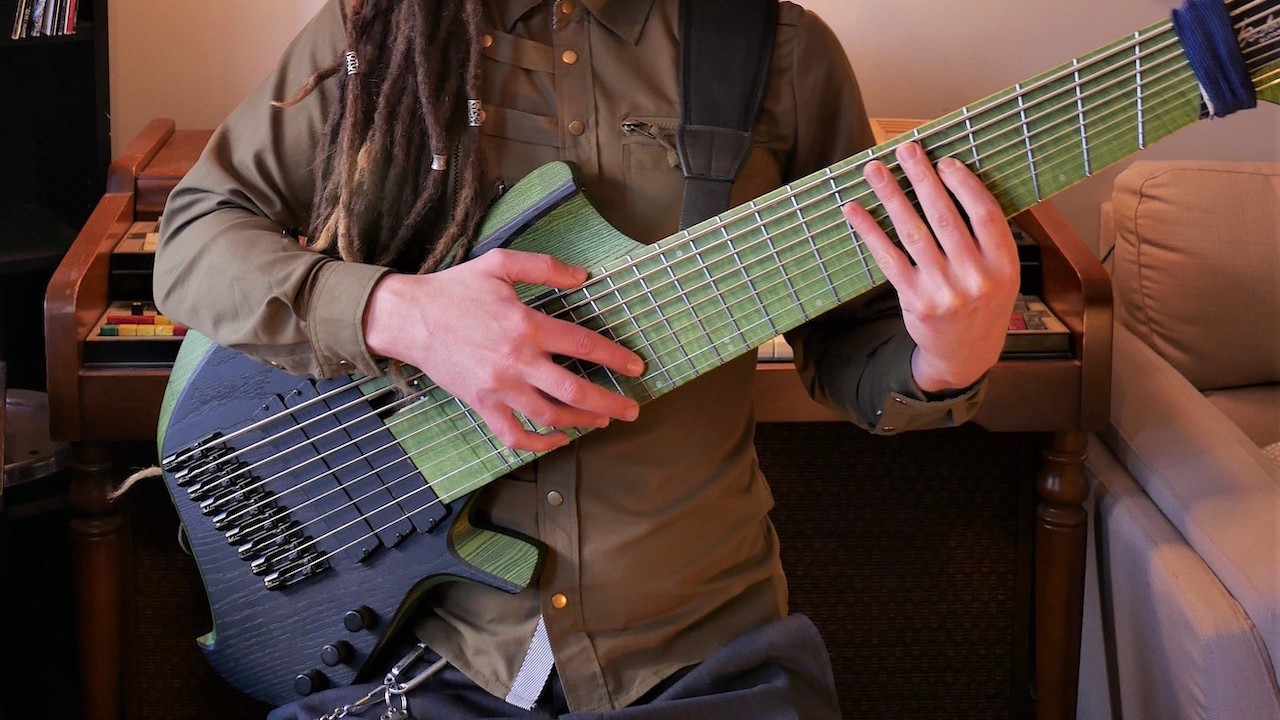“My custom 9-string bass is just as playable as any 4-string Fender!” ChaotH on the unorthodox world of the extended-range bass
Watch the Vvon Dogma I bassist put his fretboard fitness to the test on this custom-made 9-string bass guitar

When bassist Frédérick Filiatrault (aka ChaotH), former member of avant-garde metal band Unexpect, wanted a bass guitar with an extended-range, his relentless search for new sounds led to the creation of a 9-string bass guitar, an instrument that also boasts a fanned-fret fingerboard and seemingly endless playing possibilities. “My main axe now is an Ennea 9-string bass by Padalka Guitars,” he says. “It’s an awesome instrument that gives me a totally different vision of the fretboard. It's really the sweet spot between a bass guitar and a Chapman stick.”
Knowing that some bass players may find the unorthodox world of the extended-range bass, or ERB to those in the know, concept a little worrying, he explains: “You can still visualise the standard 4-strings on the fretboard, but you also have two lower strings and three higher strings on either side. My 9-string is just as playable as any 4-string Fender. It just dares you to go a bit further.”
His most recent playthrough video, Day of the Dead, combines all manner of picking, slapping and tapping, combining an expansive compositional approach with his virtuosic technique. "I guess the style that I’m often associated with is prog, which means playing lots of notes goes hand-in-hand with having too many strings! The aim was to bring the 9-string bass forward, but I also wanted to focus on songwriting and not just fretboard theatrics”
Like so many bassists of the prog rock persuasion, the possibilities offered by extended-range instruments held an early fascination for ChaotH. “I got super into Jean Baudin in the late 1990s. He played bass for bands like Nuclear Rabbit and Element of Surprise, and he was the very first guy to use a custom 9-string bass guitar in a rock setup. Jean's playing left a big impression on me, which is why I started my own quest for more strings.”
And the secret to his lightning-speed bass chops? “You have to compress your technique, keep your attacking hand close to the instrument and always be mindful of muting the strings as best you can. Muting the treble strings is often easier as your fretting hand will naturally wrap around the instrument, but trying to control any unwanted rumbling from the lower strings can be tricky. I spent a bunch of time practicing string muting when I got my first 9-string bass in 2002. That was a Bee Bass, which I used for the Day of the Dead playthrough. Having said that, I'm still a fan of Fender. I still have two American Jazz Basses.”
Will the ERB ever be accepted by more traditional bass players? Perhaps when people get over their prejudices, he explains: “I’ve had people ask if it hurts my back or if it’s really a harp that I’m playing! I’ve heard it all over the years, so I always have my one-line answers ready to go. I think people can adapt to anything you expose them to, and I knew I could learn this instrument. Unless you knocked down seven beers and four shots of Jägermeister, and end up seeing double before the gig, it’s really not that bad.”
Day of the Dead features on the new Vvon Dogma I album, The Kvlt of Glitch. You can also study bass guitar with ChaotH via his Patreon page.
Get The Pick Newsletter
All the latest guitar news, interviews, lessons, reviews, deals and more, direct to your inbox!

Nick Wells was the Editor of Bass Guitar magazine from 2009 to 2011, before making strides into the world of Artist Relations with Sheldon Dingwall and Dingwall Guitars. He's also the producer of bass-centric documentaries, Walking the Changes and Beneath the Bassline, as well as Production Manager and Artist Liaison for ScottsBassLessons. In his free time, you'll find him jumping around his bedroom to Kool & The Gang while hammering the life out of his P-Bass.
“An esoteric boutique vibe, superb ergonomics and a powerful, unique preamp – Tobias is back”: Tobias Growler IV review
“Affordable versions of the three best basses I've ever held in my hands”: Sterling by Music Man completes its trilogy of Joe Dart signature models with a trio of made-to-order basses that cost less than $500









